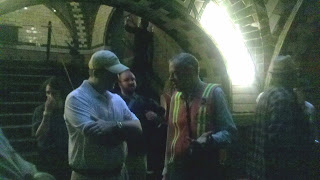There are clearly cons as well as pros, but overall I think most would agree we are incredibly fortunate (although there are often many obstacles) to have so many options.
 Following my ruminations, I decided to visit the NYC Fire Museum in SoHo. I wanted to see the old fire steam engines (see right), put on a fireman's uniform (which all visitors can do), admire the art and fire fighting memorabilia (did you know that fire bombs were initially used to fight fires? -- when they are thrown the explosion uses up all of the surrounding oxygen, thereby extinguishing fires), and most importantly pay my respects at the permanent 9/11 memorial exhibit (see left).
Following my ruminations, I decided to visit the NYC Fire Museum in SoHo. I wanted to see the old fire steam engines (see right), put on a fireman's uniform (which all visitors can do), admire the art and fire fighting memorabilia (did you know that fire bombs were initially used to fight fires? -- when they are thrown the explosion uses up all of the surrounding oxygen, thereby extinguishing fires), and most importantly pay my respects at the permanent 9/11 memorial exhibit (see left). There are numerous fire trucks, beginning with hand pumped contraptions and horse drawn steam engines to more modern gas engined trucks and parade carriages (see right). There are also stove top hats (originating in PA) and the earliest fire fighter hats with the wide back brim to shed water (originating in NY). You can read about the history of volunteer fire fighting, the technological and equipment advances, as well as an early 1800s cholera scare that had people avoiding all water (getting wet was discouraged as was drinking cold water!).
As a dog fanatic, I was also particularly moved (and admittedly a little grossed out) by the stuffed dog in one display (see left). This dog, named Chief, had rescued numerous people as well as a cat and kittens from various fires and on November 25th, 1936 was awarded Dog World's International Diploma of Honor. There are also numerous pictures of various fire departments pictured with their dog mascots, who originally were fostered by fire houses to run alongside the horse-drawn fire trucks to keep stray dogs away from the horses. At first, any dogs that found their way to a fire house welcome, but soon dalmatians began to become favored for their ability to run long distances without tiring alongside the horses.
This is a great little museum, and I would highly recommend a visit, especially if you are in the market for any FDNY paraphernalia or a little fireman's Halloween costume. Check out their hours and admission prices at their website at Fire Museum.

















































